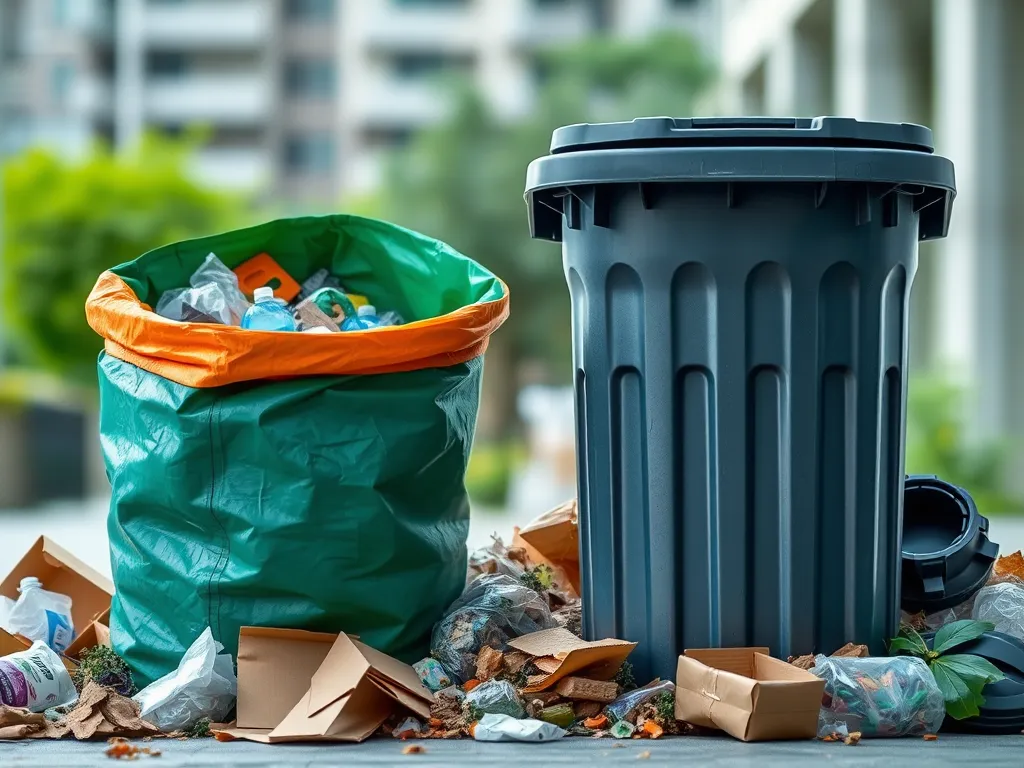Exploring Dumpster Bags vs. Bins: Which is Best?

Dumpster Bags vs. Bins: A Comprehensive Comparison
When it comes to waste disposal, the debate between dumpster bags and bins is a common consideration for both homeowners and contractors. Dumpster bags vs. bins provides a crucial overview of two popular options for managing waste, especially during major projects such as renovations or landscaping. Understanding the key differences in cost, capacity, convenience, environmental impact, and specific usage scenarios can help individuals choose the right solution for their waste management needs.
Dumpster bags and bins cater to different waste management requirements, each presenting unique advantages and disadvantages. Dumpster bags, often made from durable material, can hold a substantial amount of waste and are portable, making them easy to transport. On the other hand, bins offer sturdiness and are often stationed at a designated location, making them suitable for ongoing projects. This article dives deep into the dumpster bags vs. bins comparison, allowing readers to make informed decisions based on their specific situations.
Cost is always a major factor when selecting between dumpster bags and bins. While dumpster bags have a lower initial purchase price, the long-term costs can vary significantly depending on the frequency of use and disposal fees. Bins often come with a monthly rental fee, which can accumulate over time. Therefore, understanding the cost implications of dumpster bags vs. bins is essential for achieving budget-friendly waste disposal.
Capacity is another critical aspect in the dumpster bags vs. bins debate. While dumpster bags typically accommodate a large volume of waste, they may not always offer the same capacity as a full-size bin. Choosing the right size for your project can have a significant impact on efficiency and waste management, particularly when considering the space available for storage and accessibility.
The sustainability initiatives at South Dakota State University showcase the commitment to environmental stewardship on campus.
Ultimately, understanding the nuances in convenience and accessibility can aid in making the right choice between dumpster bags and bins. While bags are easy to transport, bins can be more challenging to maneuver in tight spaces. Analyzing factors such as drop-off strategies, pick-up logistics, and user-friendliness in residential areas will provide crucial insights for homeowners and contractors alike.
Cost Comparison of Dumpster Bags and Bins
The initial cost of dumpster bags is generally lower compared to bins. A single dumpster bag can be purchased for about $30 to $60, depending on the size and material quality. In contrast, renting a bin often requires an upfront payment of $300 or more, which may include delivery and pickup fees. This initial expenditure can significantly influence your decision if you anticipate using the option frequently or infrequently.
Long-term rental costs for bins can overshadow the initial purchase price of dumpster bags. Monthly rental fees for bins typically range from $150 to $500 depending on the size and service provider. If you plan to keep the bin for an extended period, those costs can add up quickly, resulting in a heftier overall expense compared to purchasing a few dumpster bags.
Disposal fees associated with each option also play a crucial role in the cost comparison. While both options may incur fees based on the weight of the disposed waste, bins might require a higher fee for excess weight due to the constant monitoring required. Conversely, dumpster bags often have a straightforward cost structure, which can make predicting expenses simpler and more manageable.
Potential savings based on usage frequency can further tilt the scales toward either dumpster bags or bins. If you have a one-off project, like spring cleaning or a small renovation, dumpster bags may be the way to go. However, if you find yourself needing to dispose of waste on a consistent basis, renting a bin can ultimately be more economical in the long run.
Capacity and Size Differences
Typical sizes of dumpster bags range from 3 to 5 cubic yards, whereas bins come in various sizes, often ranging from 10 to 40 cubic yards. For small projects, dumpster bags may suffice, but for larger jobs, having a sufficient bin can prevent multiple trips to dispose of waste.
The capacity of the chosen option can significantly impact project choices. If your project involves significant debris or waste generation, selecting a larger bin can save time and the hassle of numerous trips to the disposal site. Alternatively, smaller projects that generate minimal waste might not justify the rental cost of a bin and would benefit more from purchasing a dumpster bag.
Space requirements for storage differ based on the chosen option as well. A bin tends to require a more significant footprint, potentially causing issues in small yards or narrow driveways. On the other hand, dumpster bags can be compactly stored, allowing homeowners with limited space to efficiently manage their waste disposal needs.
Choosing the right size for your waste is essential. It’s important to assess the waste volume and type generated by your project to determine whether a dumpster bag or a bin is the appropriate fit. By accurately estimating the quantity and volume of materials, you can avoid unexpected costs associated with overage fees or insufficient capacities.
Convenience and Accessibility
Ease of transport for dumpster bags is one of its major advantages. They can be easily moved from one location to another and require minimal effort to set up. In contrast, bins are typically stationary and may require professional handling for pick-up or delivery, which could limit their convenience in specific scenarios.
Accessibility of bins in tight spaces is a crucial factor to consider. If you are working in a confined area or alleyway, dumpster bags may be preferable as they can fit into smaller spots without compromising accessibility. Bins, on the other hand, may require more space to operate effectively, limiting their usability in challenging locations.
Drop-off and pick-up logistics can vary based on the waste disposal method chosen. Dumpster bags can usually be delivered and picked up on-demand, providing flexibility for your project timeline. In contrast, bins may need to adhere to scheduled pick-up times, potentially causing disruptions if logistics are not accurately managed.
User experience in residential areas can differ greatly based on the selected option. Dumpster bags tend to cause less disruption in neighborhoods, as they can be placed on private property and removed when full. On the other hand, bins can obstruct driveways or sidewalks, creating inconveniences for residents and traffic.
Environmental Impact of Waste Disposal Options
Recycling potential of materials often depends on how the waste is managed. Some companies that offer dumpster bags may have recycling programs in place, allowing users to sort recyclable materials easily. Bins, frequently used for collection via municipal services, may also provide recycling options but require more organization from users to ensure responsible waste management.
Landfill contributions from each option can vary based on the efficiency of waste sorting. If the materials are not properly sorted, both dumpster bags and bins can contribute to landfill overflows. It is essential to evaluate your waste and bulk disposal practices to minimize environmental impacts regardless of the chosen method.
Best practices for eco-friendly disposal should be at the forefront of any waste management discussion. Utilizing a waste disposal option that encourages recycling and composting can significantly reduce landfill contributions. Engaging with local providers who practice responsible waste management can help in finding options that prioritize environmental stewardship.
Local regulations affecting disposal methods can influence the selected choice. Some areas may have specific rules regarding waste disposal, particularly concerning the types of materials that may and may not be placed in dumpster bags or bins. Familiarizing yourself with local guidelines is essential to ensure compliance and promote sustainable practices in waste management.
Usage Scenarios: When to Choose Bags or Bins
Best projects for dumpster bags include minor renovations, seasonal yard clean-ups, or household clutter removal. The convenience and compact nature of dumpster bags provide a less invasive solution for disposal in residential areas, making them an ideal choice for one-time projects.
Recommended situations for using bins often include extensive construction jobs, significant landscaping projects, or commercial waste disposal. Their larger size and regular pick-up services can accommodate substantial waste generation, eliminating the need for constant trips to the waste facility.
Home renovations vs. yard waste present an essential distinction in the dumpster bags vs. bins debate. For indoor renovations where indoor space is limited and debris is light, dumpster bags may serve well. However, outdoor projects producing heavy green waste or construction debris may require a bin for efficient waste management.
Tips for selecting the right option based on project size are paramount. For small, quick jobs, dumpster bags are ideal. For larger, ongoing projects or when waste generation is significant, opting for a bin can offer more efficiency and reduce stress related to disposal logistics.
